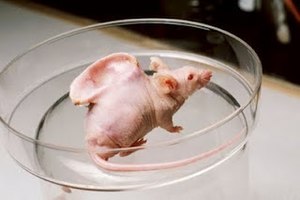Vacanti mouse

The Vacanti Mouse was a laboratory mouse that had what looked like a human ear grown on its back. The "ear" was actually an ear-shaped cartilage structure grown by seeding cow cartilage cells into a biodegradable ear-shaped mould and then implanted under the skin of the mouse, then the cartilage naturally grew by itself.[1]
The earmouse, as it became known, was created by Charles Vacanti and colleagues in the Department of Anesthesiology (University of Massachusetts Medical School) and their results were published in 1997. The mouse itself is called a nude mouse, a commonly used strain of immunocompromised mouse, preventing a transplant rejection.
The photo of the mouse was passed around the internet, mainly via email, sometimes with little to no text accompanying it leading many people to speculate whether the photo was real. In the late 1990s, the picture prompted a wave of protests against genetic engineering—although in this specific experiment no genetic manipulation was performed. Even the strain of mouse used is not genetically modified; it is the result of a spontaneous natural genetic mutation.
References
- ^ Cao, Y.; Vacanti, J. P.; Paige, K. T.; Upton, J.; Vacanti, C. A. (1997). "Transplantation of chondrocytes utilizing a polymer-cell construct to produce tissue-engineered cartilage in the shape of a human ear". Plastic and reconstructive surgery. 100 (2): 297–302, discussion 303–4. doi:10.1097/00006534-199708000-00001. PMID 9252594.
